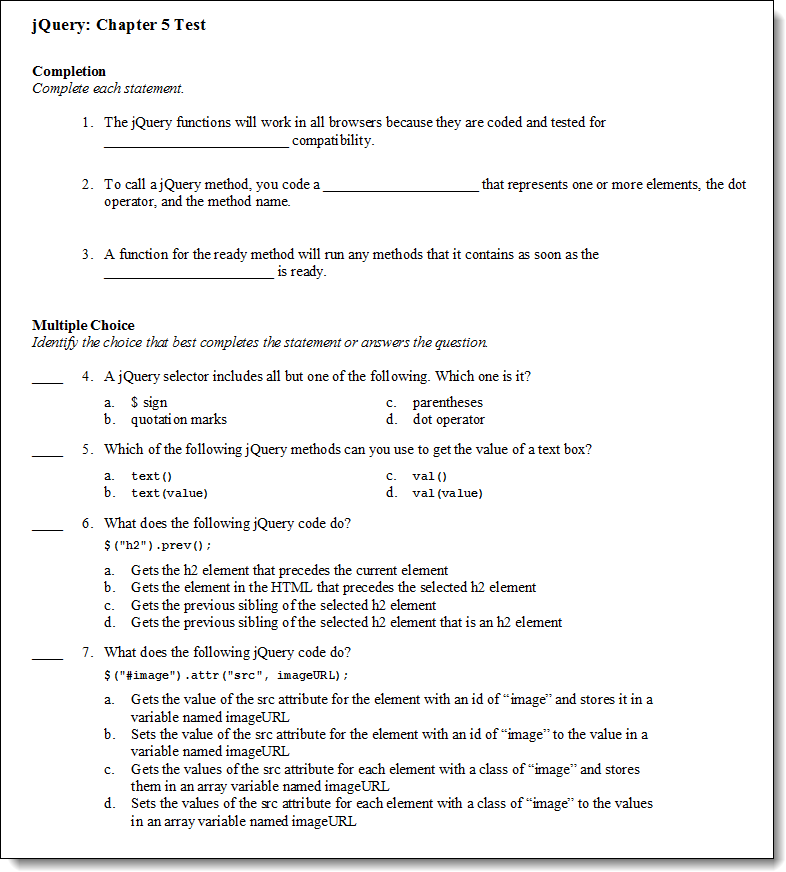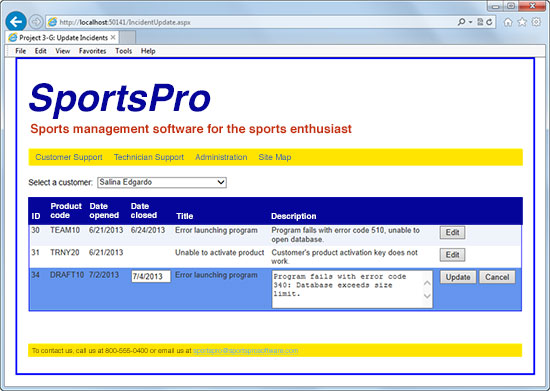What Our Courseware Includes
Chapter exercises and solutions

Each chapter in our books ends with exercises that let your students practice and gain confidence in the skills they’ve just learned. And to supplement these exercises, we offer a download at our website that contains:
- the starting code for most exercises (that is, the code that any professional would copy in from a finished application)
- the exercise solutions, so your students can avoid getting stuck when they’re working on their own and can check their solutions against the author’s to see what, if anything, they could have done better (these are also a service to the professional developers who use our book for self-training)
- all the book applications, so your students can experiment with them and cut-and-paste code into their exercise solutions
We include these materials in the instructor’s materials as well so that you can demo them in class or modify them and hand out copies to your students.
Instructional objectives

We believe that instructional objectives should be the start of any educational methodology, so our courseware includes a set of objectives for each chapter in each book. We develop these according to the principles presented by Robert F. Mager in his classic book, Preparing Instructional Objectives. As a result, our objectives describe the skills that your students should be able to do when they complete a chapter.
We divide our objectives into two categories. Our applied objectives ask the students to apply what they’ve learned to real-world problems. These are the critical objectives of a course, and they are best tested by having the students do exercises, projects, and case studies like the ones that we provide.
In contrast, our knowledge objectives define skills like identifying, describing, and explaining the required concepts, terms, and procedures. These objectives determine whether your students are able to talk intelligently about the topics that are presented. And these objectives can be tested by the test banks that we provide.
To help you get the most from the instructional objectives, we include them at the start of the PowerPoint slides for each chapter, as shown above. If you can convince your students that they only need to be able to do the skills that are described by the objectives, their study becomes more focused and efficient…and more rewarding.
Test banks

To test comprehension, our courseware includes one test bank for each chapter in each book. We develop these test banks in ExamView, but we provide them in multiple formats. (And if you ever need a format we don’t provide, please ask us about it; we’ll see what we can do.)
Each test bank provides questions that are designed to test the skills that are described by the objectives for that chapter, and each test question is designed to test the skill described by one objective. This keeps the promise to the students that they will only be expected to do the skills that are described by the objectives.
Extra exercises

Because we provide the solutions for the book exercises in the student download, the courseware for each book offers one or more sets of extra exercises for you to use. Each set includes: (1) the student handout that describes the exercises; (2) the starting folders and files to distribute to your students; and (3) the folders and files for the solutions so you can demonstrate and review them in class.
In other words, you can use the book exercises for practice, since the solutions are available to your students. Then, you can use the extra exercises to enhance your course as you see fit.
One way to use the extra exercises is to provide quick reinforcement for a skill or topic that you’ve just presented. However, you can also use them as quizzes or tests. If your students understand the concepts, they should be able to do each exercise in the allotted time. If they don’t, this will help them realize what they need to know. Call it reinforcement, call it classroom stimulation, call it a quiz, or call it a test: the extra exercises can make any course more effective.
Projects and Case Studies

For many of our books, we also offer projects or case studies that continue from one chapter or section to the next. Then, each project or case study represents a single application that is started from scratch after the first section of the book and can be enhanced by using the skills of each subsequent chapter or section.
For instance, the example above is one page of a technical support web application that can be used with our PHP book. This application starts with two web pages that the students build from scratch after they complete chapter 6. Then, the students add pages to the application after they complete subsequent chapters. This is the best test of whether your students are able to apply what they’ve learned to applications that are new to them.
PowerPoint slides

The PowerPoint slides in the courseware present all of the critical information that’s presented in the figures (illustrations) of the book. That includes all of the screenshots, diagrams, tables, syntax, and code that you may want to review in class. As a result, these slides make it easy for you to review any of the skills that your students have difficulty with.
Beyond the book information, the slides for each chapter start with the instructional objectives, so you can review them in class. And for most of our books, the slides for each chapter end with the screenshots for the book exercises, as well as for the extra exercises that we offer. That makes it easy for you to answer questions and provide additional information about these exercises.
Canvas courses
For most of our bestselling books, we provide a Canvas course file that includes all of the objectives, quizzes, assignments, and PowerPoint slides that you need to run an effective course. This file makes it easy to import these instructional materials into Canvas. It only takes a few clicks! After you import the file, the instructional materials will already be organized into modules where each module corresponds to a chapter in the book. Then, you can customize these modules so they’re right for your course.
If you have suggestions for improving these Canvas course files, please let us know! Our goal is to provide the instructional materials you need, so we always appreciate any of your feedback.




